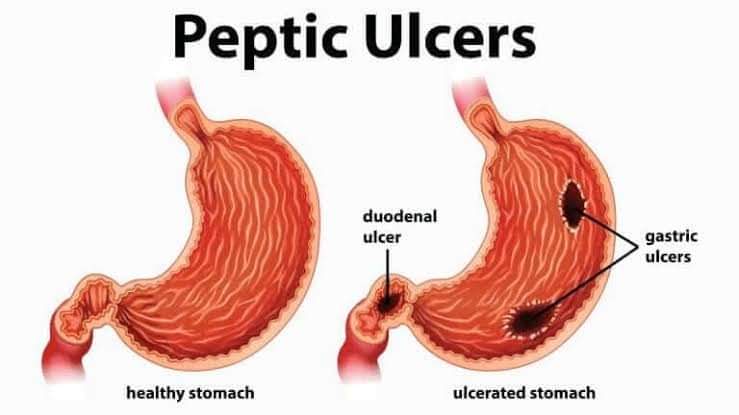Questions for Viva:
✏ Tell the anatomical position of the stomach?
Ans
■ The anterior superior surface faces superiorly & posterior surface faces inferiorly ( in empty stomach )
■ The cardiac orifice is situated about 2.5cm left to the median plane.
■ The pyloric orifice is situated 1.25 cm right to the median plane.
■ The lesser curvature is concave and to the right.
■ Greater curvature is convex and to the left.
✏ What is stomach?
Ans:
• It is a mascular bag forming the widest & most distensible part of the digestive tube.
✏ Where the stomach is situated?
Ans:
• Epigastric , left hypo-chondrium and umbilical region.
✏Describe the presenting part of the stomach?
Ans:
🌀Two orifices-
cardiac and pyloric.
🌀Two curvatures-
lesser and greater.
🌀Two surface:
antero-superior , postero- inferior.
🌀Three subdivision :
fundus, body and pyloric part
✏How the stomach parts are divided?
Ans:
🌀Fundus from the body : Divided by a horizontal line passing from the cardiac notch.
🌀Body from pyloric antrum : Divided by an oblique line passing from the incisura angularis to the most distensible part of the greater curvature
🌀Pyloric antrum from pyloric canal : Divided by sulcus intermedius
✏How pyloric sphincter is formed?
Ans:
• It is formed by the deep fiber of the longitudinal muscle and circular muscle.
✏ Where cardiac orifice is situated?
Ans:
🌀2.5 cm left to the median plane.
🌀 behind left 7th costal cartilage.
🌀opposite T11 vertebra.
✏ How can you identify the ends of stomach? Tell the vertebral level.
Ans:
• Pyloric end is muscular, thick and externally marked by a circular groove
Vertebral level :
🌀 Cardiac end T (11) vertebra
🌀Pyloric end lower border of
🌀 L (1) vertebra
✏ Tell the capacity of the stomach?
Ans:
🌀At birth 30 ml
🌀At puberty 1000 ml
🌀At adult 1.5-2 liters
✏ What happens when stomach is overloaded?
Ans:
• Over distension of stomach irritate the diaphragm which causes the shoulder tip pain.
✏ How the position of the stomach is maintained?
Ans:
• By the ligaments and surrounding viscera
✏What are the ligaments of stomach?
Ans:
• Gastro-splenic ligament.
• Gastro- phrenic ligament.
• Lesser omentum.
• Greater omentum.
✏ What is milky spot?
Ans:
• The collection of macrophages in the greater omentum in small, dens patches known as milky spot.
✏ What lies behind the right margin of the lesser omentum?
Ans:
• Epiploic foramen
✏ What is gastric canal? Tell its importance.
Ans:
• It is mucous gutter extending along the lesser curvature from cardiac orifice to the pyloric antrum
Importance :
• It is prominent in children
• It allows rapid passage of fluids to the lower part of the stomach.
✏ How can you identify the pyloric sphincter in living person?
Ans: By the position of prepyloric vein
✏Which is the dependent part of the stomach?
Ans: Incisura
✏Name the gland present in the stomach?
Ans:
• Cardiac glands.
• Glands of the body and fundus.
• Pyloric glands.
✏ What type of gland present in the stomach?
Ans:
• Cardiac glands – simple columner epithelium.
• Glands of body and fundus – simple tubular.
• Pyloric glands – convoluted tubular glands.
✏ Name the cell present in the gastric glands and their secretion ?
Ans:
• Mucous cells – secret mucous
• Zymogenic cells (chief cells ) – secret gastric enzyme
• Oxyntic cells ( parietal cells ) – secret HCl
• Mucous neck cells – secret mucous
• Argentaffin cells – secret gastric and serotonin
• Undifferentiated columner cells – modify into other cells.
✏ What is rogue?
Ans: Mucousal fold of stomach
✏ Function of the rugae? Tell me the location of the other part of the body?
Ans:
• Expansion of an organ after appearance of foods and liquids or urine or some other contents.
• Location
• Inside the stomach
• Inside the urinary bladder
• Inside the gallbladder
• Inside the vagina
• Hard palate
• Wrinkles of the stomach
✏What is the content of the fundus of the stomach?
Ans: Fundic gass
✏ Why gastric juice does not burn the gastric wall?
Ans:
• Because the mucous secretion form a coat along the wall and prevent the contact of HCl to the stomach wall.
✏ What are the content of submucosa?
Ans:
• Loose areolar tissue
• Arterial & nerve plexus
✏ What happens when part of gastric epithelium brun or damage?
Ans:
• It will produce gastric ulcer. If it is not treated it will be cancer
✏ Tell me the nerve supply of the stomach?
Ans:
• Sympathetic : From T4-T10 segments
• Para sympathetic : By vagus nerve
✏ Which surface of stomach is supplied by which vagus nerve and why?
Ans:
• Left vegul trunk: supply to anterior surface of the stomach
• Right vegul trunk : supply to posterior surface of the stomach
Because left vegul trunk becomes anterior and right vagal trunk becomes posterior. Due to clockwise rotation of the stomach during its development
✏Tell the length of the stomach?
Ans: 25 cm
✏What are the other organ having same length?
Ans:
🌀 Oesophagus
🌀Duodenum
🌀Descending colon
🌀Ureter
✏ Where the Myenteric and Misceners plexus are located?
Ans:
• Myenteric plexus : It lies between longitudinal and circular muscle layer.
• Misceners plexus : It lies within the submucosal layer
✏ Tell the action of sympathetic and parasympathetic nerve on gastric wall and gastric glands?
Ans:
• Sympathetic : vasomotor , motor to pyloric sphincter, inhibition gastric secretion and pathway of pain sensation
• Parasympathetic : Motor to gastric wall and secretomotor gastric glands.
✏ What happens when both vagus nerves are cut down?
Ans:
• Stomach becomes flaccid.
• It empties slowly, No HCl is secreted
✏ Why the left curvature is larger?
Ans: Because durning the development the lesser curvature ( Fixed border) remains attached to the liver & the growth takes place gards the greater (free border). This is why left curvature is longer.
✏ Developmentally what the surfaces & borders represent?
Ans :Developmentally –
- Left curvature represents posterior border.
- Right border represents anterior border.
- Anterior surface represents left surface.
- Posterior surface represents right surface.
✏ Tell the histological structure of the stomach?
Ans: a.Serous coat.
b.Muscular coat: -outer longitudinal, middle circular, inner reticular.
c. Sub-mucous coat.
d. Mucous coat: lined by simple columner epithelium.
✏ Tell the development of the stomach?
Ans:
a. Lining epithelium and gastric gland is developed from endoderm of foregut.
b. Muscular, connective tissue and other layer is developed from splanchopluric layer of lateral plate mesoderm.
✏ Tell the function of sympathetic nerve supply in case of stomach?
Ans:
a. Keep the food in the stomach.
b. Reduce the secretion of gastric gland.
c. Contraction of the pyloric sphincter.
d. Relaxation of gastric muscle.
✏ What is the lining epithelium of the stomach?
Ans: Simple columner epithelium.
✏ What is the situation of gastric gland?
Ans: lamina propria.
Reference :"Basic Anatomy Viva Question for First Professional Examination"WRITTEN QUESTION:
✏Short Note:Stomach Bed
Stomach Bed: The structures lying under the postero – inferior surface of the stomach which is covered with the peritoneum of the lesser sac and forms a shallow fossa upon which the stomach rests in recumbent supine position is called stomach bed.
Structures forming the stomach bed:
🌀Left crus of the diaphragm.
🌀Left supra renal gland.
🌀Anterior surface of left kidney.
🌀tortuois splenic artery.
🌀Anterior surface of the pancreas.
🌀Transverse mesocolon.
🌀Left colic flexure.
🌀Gastric surface of spleen.

✏What is gastric canal? How it is formed? Give the clinical importance.
Ans:
Gastric Canal: It is a longitudinal furrow
that forms temporarily during swallowing
between the longitudinal folds of the mucosa along the lesser curvature.
It forms due to firm attachment of the gastric mucosa to the underlying muscular layer which doesn’t have
an oblique layer at this site.

Importance :
This canal allows a rapid passage of swallowed liquids along the lesser curvature to the lower part before it spreads to the other part of the stomach.
✏Give an account of the lymphatic drainage of stomach.
Ans:
Lymphatic drainage of stomach:
🌀From the part of the stomach to the left of a vertical line drawn from the cardiac orifice drains into pancreatico – splenic lymph nodes. A few lymphatics are intercepted by para-cardiac lymph nodes.
🌀From the upper two-third of the right part of the stomach lymph vessels drain into left gastric lymph nodes.
🌀From the lower one-third of the right part the lymph vessels drain into right gastro-epiploic lymph nodes and then to the pyloric lymph nodes.
🌀From the pyloric part lymphatics drain in three direction:
• Into hepatic group,at the porta hepatic,
• Into the pyloric group, below the pyloric orifice;&
• Into left gastric lymph nodes.
The above lymph nodes ultimately drain into coeliac lymph nodes.

✏ Draw and level artery supply of the stomach.
Ans:
Left Gastric Artery: It is the branch of coeliac trunk & supplies the cardiac part of stomach.
Right Gastric Artery: Branch of Hepatic Artery & supplies lower right part of stomach.
Short Gastric Arteries: Branch of splenic artery & supplies the fundus.
Left gastro – epiploic artery: Branch of splenic artery & supplies upper part of greater curvature.
Right gastro- epiploic artery: Branch of gastro – duodenal artery & supplies lower part of greater curvature.

CLINICAL QUESTION :
✏ Explain why lesser curvature of stomach is more prone to gastric ulcer?
Ans.
Peptic ulcer occurs along the lesser curvature of stomach:
This is possibly due to the following peculiarities of the lesser curvature-
🌀Less mobile mucosa over the muscular coat.
🌀The epithelium is comparatively thin.
🌀Blood supply is less abundant and there are fewer anastomoses.
🌀Absence of submucous plexus.
🌀Nerve supply is more abundant with large ganglia.
🌀Gastric canal lies along it which receives most of the insult from irritating drinks.
🌀 H. pylori infection is also an important causative factor.

Dewan Sobuz.
Dhaka Community Medical College & Hospital
⚫প্ল্যাটফর্ম একাডেমিক/সাহিনা আক্তার সুমা⚫

